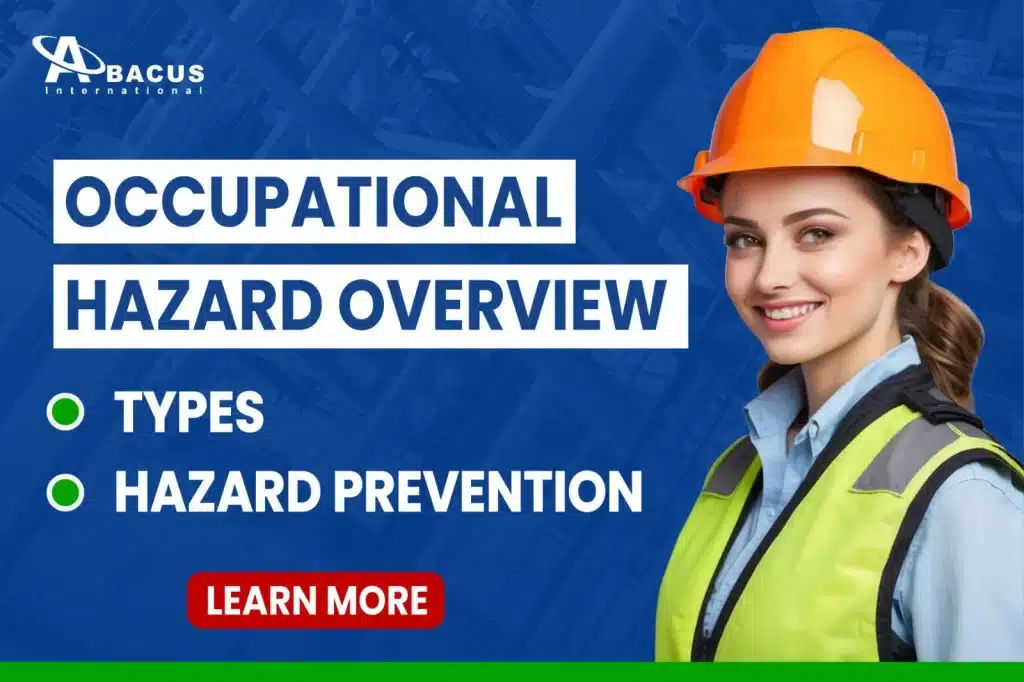Occupational hazards are risks or dangers that arise in the workplace, potentially leading to injuries, illnesses, or other harmful outcomes for employees. These hazards can vary greatly depending on the industry, working conditions, and specific tasks employees are performing.
Understanding and preventing occupational hazards is crucial not only for employee safety but also for maintaining a productive and legally compliant workplace.
Also Read: All You Need to Know about Workplace Safety
Types Of Occupational Hazards
There are 5 types of workplace hazards which can affect workers differently depending on their roles and industries. Let’s discuss about them in detail:
1. Physical Hazards
Physical hazards are the most common and are associated with environmental factors that can cause harm.
- Noise Exposure: Constant exposure to loud noises, especially in industries like construction or manufacturing, can lead to hearing damage or loss.
- Temperature Extremes: Jobs that expose workers to very high or low temperatures, such as foundries or refrigerated warehouses, pose risks of heatstroke or frostbite.
- Vibration Risks: Operating machinery that vibrates can lead to long-term health issues, including musculoskeletal disorders.
2. Chemical Hazards
Chemical hazards occur when workers are exposed to harmful substances.
- Exposure to Toxic Chemicals: Many industries, such as pharmaceuticals, cleaning services, or painting, involve working with dangerous chemicals that can cause acute or chronic health problems, including respiratory issues or skin diseases.
- Common Industries Affected by Chemical Hazards: Chemical, pharmaceutical, and agriculture sectors are some of the most at-risk industries.
3. Biological Hazards
Biological hazards come from exposure to infectious agents.
- Viruses, Bacteria, and Other Pathogens: Healthcare workers are particularly vulnerable to these hazards. However, workers in agriculture, waste management, and laboratories also face risks from biological agents.
- Occupations at Higher Risk for Biological Hazards: Healthcare workers, veterinarians, and agricultural workers are at high risk for biological hazards.
4. Ergonomic Hazards
Ergonomic hazards stem from poorly designed workplaces or tasks.
- Repetitive Motion Injuries: Typing for extended hours or repeatedly lifting heavy objects can result in musculoskeletal disorders.
- Poor Workstation Design: Workstations that are not ergonomically friendly can cause strain on workers’ bodies, leading to issues like carpal tunnel syndrome or back pain.
5. Psychosocial Hazards
Psychosocial hazards impact mental health and well-being.
- Workplace Stress and Mental Health: High workloads, tight deadlines, and long working hours can lead to stress, burnout, and mental health issues.
- Bullying and Harassment: Toxic workplace environments, where bullying or harassment occurs, can severely affect mental health and productivity.
Also Read: Common Causes of Industrial Accidents
Legal Framework and Regulations
Many countries have strict regulations to protect workers from occupational hazards. In the U.S., for example, the Occupational Safety and Health Administration (OSHA) enforces standards to ensure safe and healthy working conditions. Compliance with such regulations is essential for businesses to avoid fines and lawsuits.
Also Read: Commonly Overlooked Safety Issues
How to prevent occupational hazards
Effective hazard prevention involves a proactive approach. Here are some essential measures companies can implement:
Risk Assessment
Regular hazard assessments help identify potential risks in the workplace.
- Importance of Regular Hazard Assessments: Regular evaluations can prevent accidents before they happen.
- How to Conduct a Risk Assessment: A step-by-step approach involves identifying hazards, evaluating risks, and implementing control measures.
Training and Awareness Programs
Educating employees on the dangers they may face is critical.
- Educating Employees About Potential Risks: All employees should be made aware of the hazards relevant to their roles.
- Ongoing Safety Training: Regular updates and refreshers help keep safety front of mind.
Also Read: Common Safety Signs & Their Meanings
Personal Protective Equipment (PPE)
PPE acts as the last line of defense against hazards.
- Different Types of PPE for Various Industries: From hard hats to respirators, you can choose from different types of PPE depending on the industry.
- Ensuring Proper Use of PPE: Proper training is essential to ensure that PPE is used effectively.
Engineering Controls
Modifying the work environment can eliminate or reduce hazards.
- Modifying the Workplace Environment: Solutions like installing ventilation systems or using soundproofing materials can minimize risks.
- Examples of Effective Engineering Controls: Installing safety guards on machinery or improving ventilation systems are common controls.
Also Read: Essential Industrial Safety Equipment’s
Frequently Asked Questions (FAQs)
1. What is the difference between physical and ergonomic hazards?
Physical hazards and ergonomic hazards are both common in many workplaces, but they refer to different types of risks.
- Physical Hazards: These are environmental factors or substances that can cause harm to workers. Common examples include extreme temperatures (too hot or too cold), loud noises, exposure to radiation, slips, trips, falls, and contact with sharp objects or heavy machinery. These hazards are often immediate and visible, posing direct risks of injury or harm.
- Ergonomic Hazards: Ergonomic hazards are related to the design of a workspace and the physical strain that workers may experience due to poor posture, repetitive motions, or improper handling of equipment. For example, tasks that require employees to work in awkward postures for extended periods, like bending over or twisting, can lead to musculoske letal disorders (MSDs). Repetitive strain injuries (RSIs) from tasks like typing or operating machinery are also a key concern in ergonomic hazards.
Difference: The key distinction between physical and ergonomic hazards is that physical hazards are often external environmental factors, while ergonomic hazards arise from the way tasks are performed or the physical strain they cause. Physical hazards tend to result in immediate injuries (e.g., a cut from a sharp object), while ergonomic hazards generally lead to long-term injuries, such as back pain or carpal tunnel syndrome, due to continuous strain over time.
2. What role does PPE play in occupational hazard prevention?
Personal Protective Equipment (PPE) plays a critical role in preventing occupational hazards by acting as the last line of defense between workers and potential risks.
- Protection from Physical Hazards: PPE such as helmets, gloves, and steel-toed boots protect workers from physical injuries like falling objects, cuts, or burns. For example, construction workers wear hard hats to protect against head injuries from falling debris, while welders use protective visors and gloves to prevent burns.
- Chemical Hazard Protection: For workers exposed to hazardous chemicals, PPE like gloves, goggles, and respirators are essential. These prevent harmful substances from coming into contact with the skin or being inhaled, which can prevent chemical burns, poisoning, or respiratory issues.
- Biological Hazard Prevention: In healthcare and laboratory settings, PPE is crucial for protecting against biological hazards such as viruses, bacteria, and other pathogens. Items like masks, gowns, gloves, and face shields prevent exposure to infectious diseases.
- Limiting Ergonomic Hazards: While ergonomic hazards are typically addressed by improving workspace design, certain PPE can also help. For example, back braces or support belts are often used in jobs that require heavy lifting, providing support to prevent musculoskeletal injuries.
- Enhanced Psychological Safety: In some environments, such as hazardous waste management or firefighting, having proper PPE can also contribute to psychological well-being. Workers may feel more secure and less anxious about their safety when they are properly protected.
However, PPE should be seen as the last line of defense. Employers should first try to eliminate or reduce hazards at the source before relying on PPE. That said, it remains an essential tool for minimizing risks when other measures aren’t sufficient.
3. How do biological hazards affect non-healthcare workers?
While biological hazards are often associated with healthcare settings, they can also pose risks to workers in other industries.
- Food Industry Workers: Those working in food production, handling, or processing can be exposed to bacteria, viruses, and parasites that may contaminate food. For example, workers in meat processing plants are at risk of exposure to pathogens like Salmonella or coli, which can cause foodborne illnesses.
- Agricultural Workers: In agriculture, workers are exposed to biological hazards such as zoonotic diseases (diseases transmitted from animals to humans), including avian flu, anthrax, and Lyme disease. Handling livestock, crops, or soil can expose workers to bacteria, viruses, and fungi.
- Waste Management and Sanitation Workers: Those working in waste collection or sanitation are exposed to biological hazards through human waste, medical waste, or contaminated materials. Contact with bloodborne pathogens or infectious microorganisms is a significant risk, especially when handling materials that have not been properly disposed of.
- Laboratory and Research Workers: Non-healthcare workers in labs or research facilities are also at risk of exposure to biological hazards when working with live organisms, viruses, or bacteria. Accidents involving cultures or specimens can lead to infections.
- Office Workers During Outbreaks: Even in traditional office settings, biological hazards can emerge during disease outbreaks or pandemics. Airborne diseases like COVID-19 demonstrated how easily infectious diseases can spread in workplaces without proper ventilation, sanitation, or social distancing measures.
Conclusion: Biological hazards can affect non-healthcare workers in a variety of industries. The risks can be mitigated by following proper hygiene practices, using PPE, and adhering to safety protocols designed to prevent exposure to harmful biological agents.


